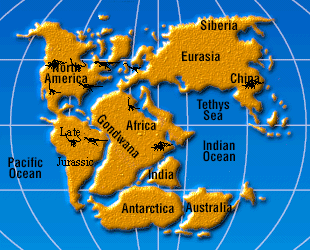
The Late Jurassic
from the Dinosaur Collector update050206

The Late Jurassic 159 - 144 million years ago is the Golden age of the Giant Sauropods. Brachiosaurus, Barosaurus, Diplodocus, Cetiosaurus and Camarasaurus roamed North America, Europe and Africa. There is still a fashion for portrayals of Brontosaurus and other Marx style classic figures even new figures are created in the Retro Classic Style. The time of the giant redwoods and sequoias. Ferns and cycads populate the under story. The Giant Sauropods Seismosaurus, Ultrasaros and Supersaurus have been found in Western North America. The large theropods Allosaurus, Ceratosaurus and Torvosaurus are the top predators. Stegosaurs reach their greatest diversity living in Europe, Africa, Asia and North America. The Walking with Dinosaurs documentary has a a segment featuring the life of a young sauropod in North America. The Morrison formation in North America and the Tendaguru dig in East Africa have produced extensive fossil finds showing that a cosmopolitan character of the dinosaur fauna. In China different families develop suggesting a degree of isolation. Giants continue to develop in the Seas of the Jurassic. Liopleurodon was a giant of the Jurassic sea. Fish, sharks and ammonites continue to evolve. The first documented birds are found in Europe at Solenhofen along with other small dinosaur fauna. Pterodactyls start to replace the rhamphorrynids. At the the end of the Jurassic the continents have separated and new plants begin to join the conifers, ferns, and cycads.
??